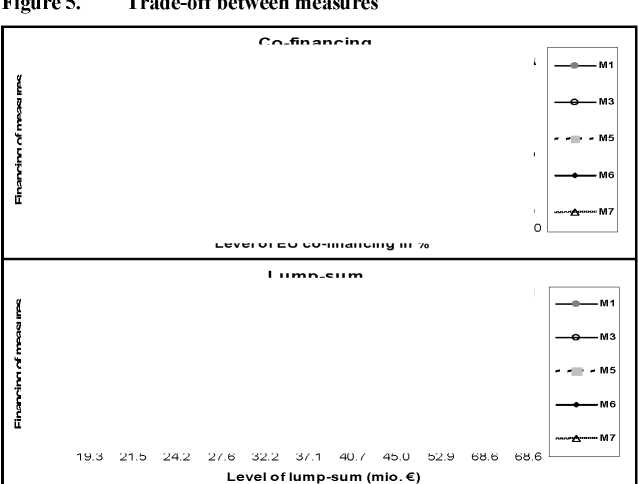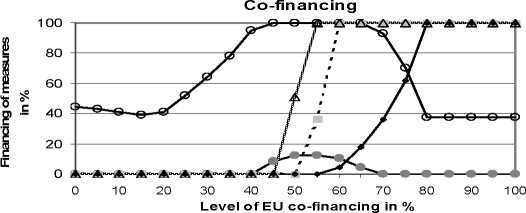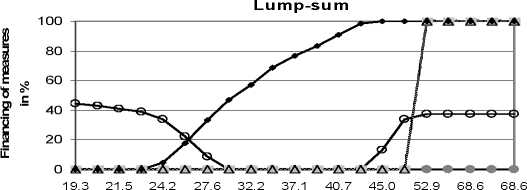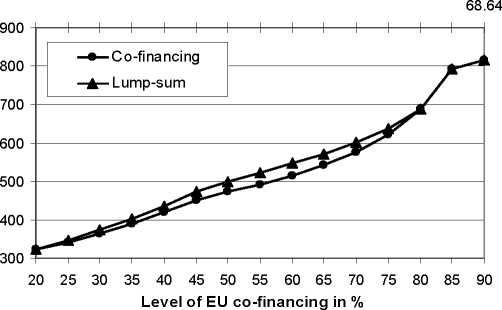Agrarwirtschaft 56 (2007), Heft 7

Source: own calculations


the lump-sum scenario in the interval between about 20%
and 80% of EU co-financing. At low and at high levels of
external grants there is no difference in the budget alloca-
tion between the lump-sum and the co-financing scenarios,
as the bias in favour to MSL measures is only relevant
within the range between about 20% and 80% EU co-
financing. At high EU co-financing levels the difference in
co-financing between MSL and VNS measures becomes so
small, that there is no distortion under the co-financing
scenario. At low financial volumes, the lower bound for
grassland causes the same choice of measures for both
scenarios; and there is no distortion in the multi-level co-
financing system.
The findings show that budget allocation and priority set-
ting for the agri-environmental programme in Saxony-
Anhalt would be different and would lead to higher “objec-
tive achievement”, if Saxony-Anhalt received federal and
EU grants as a lump-sum. In the case study considered, the
difference in the values of the objective function between
the EU co-financing system and the lump-sum scenarios
would amount to up to 6% for an EU co-financing level of
60%. Hence, the objective achievement
could be increased by this amount in an
undistorted financing system. This is con-
siderable, but not as high as might have
been expected. This is mainly due to the
specific restrictions in the case study, like
the upper bounds and grassland restric-
tions, and the objective coefficients as-
sumed.
Figure 6. Values of the objective function
Level of lump-sum (mio. €)
24.17 27.62 32.23 37.15 40.73 44.95 52.85

Source: own calculations
5. Conclusions
The influence of different mixed co-
financing schemes on regional policy-
making has been considered exemplarily
using the results of an interactive pro-
gramming approach for the case of design-
ing the agri-environmental programme of
Saxony-Anhalt. The implications of co-
financing have been discussed for several
policy scenarios.
First, the current EU co-financing system
for agri-environmental programmes cer-
tainly provides an extended financial budget for these pro-
grammes.
Second, the mixed co-financing changes priority setting and
the allocation of funds between measures. It is obvious that
a region can maximise benefits from external grants by
shifting money into measures with higher external co-
financing levels. Furthermore, the results draw a more de-
tailed picture showing that the impact of mixed co-
financing in the German system on regional policy-making
will decline when the EU co-financing level is increased,
due to a reduced difference of the external co-financing
level between measures. Respectively, the impact increases
when the EU co-financing level is reduced. For the case of
Saxony-Anhalt two opposite strategic options were dis-
cussed. If the “objective 1” status is lost, MSL measures
gain a higher priority. If on the other hand Saxony-Anhalt
retains the “objective 1” status, VNS measures gain a
higher priority due to an increased co-financing level.
Third, if Saxony-Anhalt receives EU and federal grants as a
lump-sum, giving the chance of undistorted policy deci-
sion-making, the values of the objective function are higher
in all scenarios than with co-financing.
It can be assumed that local actors have a good
knowledge about the impact of agri-environmental
measures in a region and also better represent local
preferences for the provision of public goods than
upper political levels. Therefore, the lump-sum sce-
nario shows a best and undistorted allocation of funds
from a regional point of view. The results are congru-
ent with the principle of “fiscal equivalence” and the
demand for extended and unbiased local responsibil-
ity (Osterburg and Stratmann, 2002: 276). The
case study of the agri-environmental programme of
Saxony-Anhalt underlines the general problem of
decision-making and co-financing in a multi-level
political system (Oates, 1999: 1122).
The model used for the case study in Saxony-Anhalt
reflects the specific conditions and constraints of this
region. The strength of the interactive programming
303
More intriguing information
1. DIVERSITY OF RURAL PLACES - TEXAS2. The name is absent
3. Industrial districts, innovation and I-district effect: territory or industrial specialization?
4. I nnovative Surgical Technique in the Management of Vallecular Cyst
5. TINKERING WITH VALUATION ESTIMATES: IS THERE A FUTURE FOR WILLINGNESS TO ACCEPT MEASURES?
6. Opciones de política económica en el Perú 2011-2015
7. Transfer from primary school to secondary school
8. Changing spatial planning systems and the role of the regional government level; Comparing the Netherlands, Flanders and England
9. Estimating the Technology of Cognitive and Noncognitive Skill Formation
10. Analyse des verbraucherorientierten Qualitätsurteils mittels assoziativer Verfahren am Beispiel von Schweinefleisch und Kartoffeln